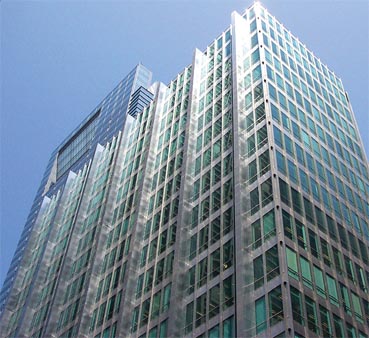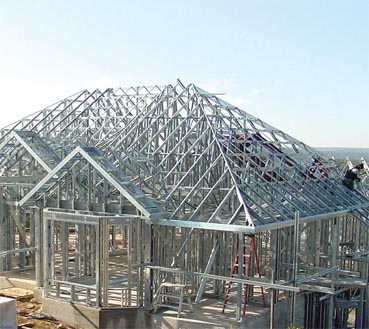
Steel is utilised in a wide range of buildings and constructions in the Middle East. It is an extremely versatile and reliable building material that represents the Arab countries expanding construction projects that have been set-up and initiated. Abu Dhabi is investing US$1 trillion into modernising every aspect of its infrastructure using steel, while the likes of Bahrain, Qatar and Oman are similarly updating their networks; Egypt on the other hand is expected to see investments of US$7.3 billion until 2015 as the sector continues to be one of the top sources of revenue for the country. The increase in steel's production volume made it much easier for producers to respond to the needs of the domestic markets. Steel can either be used to create an entire building, or be combined with other building materials. Everything from weight carrying parts to roofs, walls and covering can be made from steel. Creating an entire building from steel will make it possible to rapidly erect an affordable building without having to give up factors, such as durability, safety and design. Earlier, steel buildings were often quite unattractive and barren, but today you can get stylish steel buildings that look great and create a comfortable atmosphere. It is also common to combine steel with other types of building materials, e.g. concrete. In skyscrapers, steel is usually used to create a durable frame system, while concrete is utilised for walls, floors and roofing. When you create a steel building, different types of steel should be used for different parts of the construction. Weigh-carrying parts should for instance be made from very strong steel that is capable of withstanding all the stress that will be placed on it during the entire life of the building. When you construct an outdoor wall or protecting cover from steel, you should instead choose a steel type that has been developed especially in order to withstand the everyday wear and tear of the elements without requiring maintenance. In a building that contains large pieces of steel, light-weight steel is often a suitable choice since this will reduce the amount of stress on the weight carrying parts. So, why is some steel types heavy and others light-weight? Why should you choose a type of steel for building parts that will be exposed to a lot of tensile stress and another type of steel when you need a building material with high yield strength? To understand why there are so many different types of steel, we must take a closer look at the compounds that make up steel. Steel consists chiefly of iron atoms, but unlike pure iron, steel will also contain plenty of carbon atoms. Iron atoms form strong sheets within the alloy, but without the presence of any carbon atoms these sheets will slide pass each other, thus making the material weak. If you add carbon atoms to pure iron, the carbon atoms will prevent the iron sheets from sliding over each other, and this is why steel is many times stronger than iron and useful as a building material. Modern steel plants will vary the amount of carbon in steel in order to create a wide range of different building materials that are all perfect for their particular task. By adjusting the carbon content in steel, it is possible to affect the weight, elasticity, brittleness, hardness, ductility and tensile strength of the building material.

The more carbon a piece of steel contains, the stronger it will be. Strong steel is of course important when you create such things as weight carrying parts in a building, but too high a carbon content is undesirable since the carbon also makes the steel more brittle. Creating steel that will be used as building material is therefore always a trade-off between strength and flexibility. An iron-carbon ratio that is ideal for a steel roof might for instance be highly unsuitable for a
Nike Steel is utilised in a wide range of buildings and constructions in the Middle East. It is an extremely versatile and reliable building material that represents the Arab countries expanding construction projects that have been set-up and initiated. Abu Dhabi is investing US$1 trillion into modernising every aspect of its infrastructure using steel, while the likes of Bahrain, Qatar and Oman are similarly updating their networks; Egypt on the other hand is expected to see investments of US$7.3 billion until 2015 as the sector continues to be one of the top sources of revenue for the country. The increase in steel's production volume made it much easier for producers to respond to the needs of the domestic markets. Steel can either be used to create an entire building, or be combined with other building materials. Everything from weight carrying parts to roofs, walls and covering can be made from steel. Creating an entire building from steel will make it possible to rapidly erect an affordable building without having to give up factors, such as durability, safety and design. Earlier, steel buildings were often quite unattractive and barren, but today you can get stylish steel buildings that look great and create a comfortable atmosphere. It is also common to combine steel with other types of building materials, e.g. concrete. In skyscrapers, steel is usually used to create a durable frame system, while concrete is utilised for walls, floors and roofing. When you create a steel building, different types of steel should be used for different parts of the construction. Weigh-carrying parts should for instance be made from very strong steel that is capable of withstanding all the stress that will be placed on it during the entire life of the building. When you construct an outdoor wall or protecting cover from steel, you should instead choose a steel type that has been developed especially in order to withstand the everyday wear and tear of the elements without requiring maintenance. In a building that contains large pieces of steel, light-weight steel is often a suitable choice since this will reduce the amount of stress on the weight carrying parts. So, why is some steel types heavy and others light-weight? Why should you choose a type of steel for building parts that will be exposed to a lot of tensile stress and another type of steel when you need a building material with high yield strength? To understand why there are so many different types of steel, we must take a closer look at the compounds that make up steel. Steel consists chiefly of iron atoms, but unlike pure iron, steel will also contain plenty of carbon atoms. Iron atoms form strong sheets within the alloy, but without the presence of any carbon atoms these sheets will slide pass each other, thus making the material weak. If you add carbon atoms to pure iron, the carbon atoms will prevent the iron sheets from sliding over each other, and this is why steel is many times stronger than iron and useful as a building material. Modern steel plants will vary the amount of carbon in steel in order to create a wide range of different building materials that are all perfect for their particular task. By adjusting the carbon content in steel, it is possible to affect the weight, elasticity, brittleness, hardness, ductility and tensile strength of the building material.
Steel is utilised in a wide range of buildings and constructions in the Middle East. It is an extremely versatile and reliable building material that represents the Arab countries expanding construction projects that have been set-up and initiated. Abu Dhabi is investing US$1 trillion into modernising every aspect of its infrastructure using steel, while the likes of Bahrain, Qatar and Oman are similarly updating their networks; Egypt on the other hand is expected to see investments of US$7.3 billion until 2015 as the sector continues to be one of the top sources of revenue for the country. The increase in steel's production volume made it much easier for producers to respond to the needs of the domestic markets. Steel can either be used to create an entire building, or be combined with other building materials. Everything from weight carrying parts to roofs, walls and covering can be made from steel. Creating an entire building from steel will make it possible to rapidly erect an affordable building without having to give up factors, such as durability, safety and design. Earlier, steel buildings were often quite unattractive and barren, but today you can get stylish steel buildings that look great and create a comfortable atmosphere. It is also common to combine steel with other types of building materials, e.g. concrete. In skyscrapers, steel is usually used to create a durable frame system, while concrete is utilised for walls, floors and roofing. When you create a steel building, different types of steel should be used for different parts of the construction. Weigh-carrying parts should for instance be made from very strong steel that is capable of withstanding all the stress that will be placed on it during the entire life of the building. When you construct an outdoor wall or protecting cover from steel, you should instead choose a steel type that has been developed especially in order to withstand the everyday wear and tear of the elements without requiring maintenance. In a building that contains large pieces of steel, light-weight steel is often a suitable choice since this will reduce the amount of stress on the weight carrying parts. So, why is some steel types heavy and others light-weight? Why should you choose a type of steel for building parts that will be exposed to a lot of tensile stress and another type of steel when you need a building material with high yield strength? To understand why there are so many different types of steel, we must take a closer look at the compounds that make up steel. Steel consists chiefly of iron atoms, but unlike pure iron, steel will also contain plenty of carbon atoms. Iron atoms form strong sheets within the alloy, but without the presence of any carbon atoms these sheets will slide pass each other, thus making the material weak. If you add carbon atoms to pure iron, the carbon atoms will prevent the iron sheets from sliding over each other, and this is why steel is many times stronger than iron and useful as a building material. Modern steel plants will vary the amount of carbon in steel in order to create a wide range of different building materials that are all perfect for their particular task. By adjusting the carbon content in steel, it is possible to affect the weight, elasticity, brittleness, hardness, ductility and tensile strength of the building material.  The more carbon a piece of steel contains, the stronger it will be. Strong steel is of course important when you create such things as weight carrying parts in a building, but too high a carbon content is undesirable since the carbon also makes the steel more brittle. Creating steel that will be used as building material is therefore always a trade-off between strength and flexibility. An iron-carbon ratio that is ideal for a steel roof might for instance be highly unsuitable for aNike
The more carbon a piece of steel contains, the stronger it will be. Strong steel is of course important when you create such things as weight carrying parts in a building, but too high a carbon content is undesirable since the carbon also makes the steel more brittle. Creating steel that will be used as building material is therefore always a trade-off between strength and flexibility. An iron-carbon ratio that is ideal for a steel roof might for instance be highly unsuitable for aNike
 iConnectHub
iConnectHub
 Login/Register
Login/Register Supplier Login
Supplier Login


























